CADILLAC SEVILLE 1995 4.G Owners Manual
Manufacturer: CADILLAC, Model Year: 1995, Model line: SEVILLE, Model: CADILLAC SEVILLE 1995 4.GPages: 410, PDF Size: 19.98 MB
Page 271 of 410
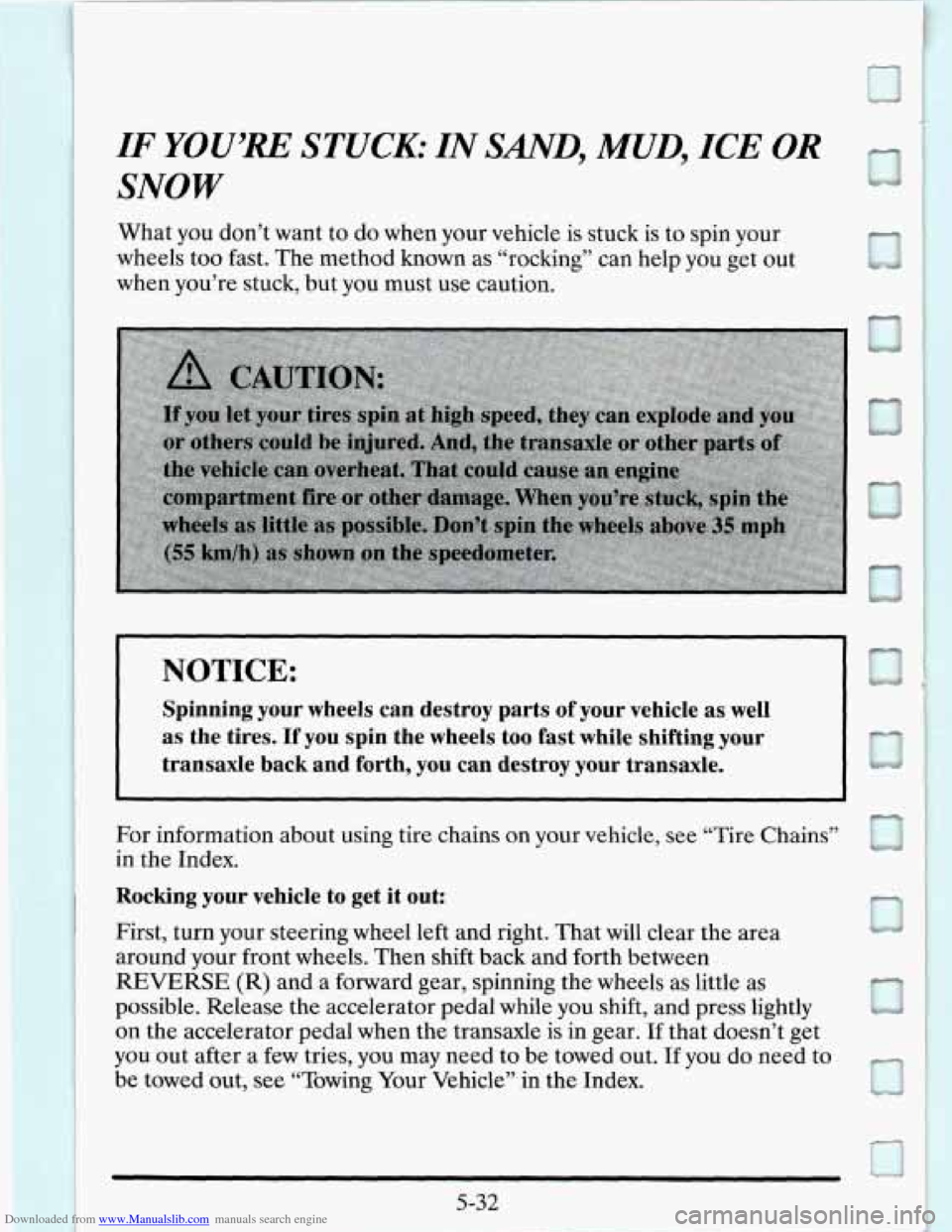
Downloaded from www.Manualslib.com manuals search engine IF YOU’RE STUCK: IN SAND, MUD, ICE OR
SNOW
What you don’t want to do when your vehicle is stuck is to spin your
wheels too fast. The method known as “rocking” can help you get out
when you’re stuck, but you must use caution.
NOTICE:
Spinning your wheels can destroy parts of your vehicle as well
as the tires. If you spin the wheels too fast while shifting your
transaxle back
and forth, you can destroy your transaxle.
For information about using tire chains on your vehicle, see “Tire Chains”
in the Index.
Rocking your vehicle to get it out:
First, turn your steering wheel left and right. That will clear the area
around your front wheels. Then shift back and forth between
REVERSE (R) and a forward gear, spinning the wheels as little as
possible. Release the accelerator pedal while you shift, and press lightly
on the accelerator pedal when the transaxle is in gear. If that doesn’t get
you out after
a few tries, you may need to be towed out. If you do need to
be towed out, see “Towing Your Vehicle” in the Index.
I
I
n U
5-32
Page 272 of 410
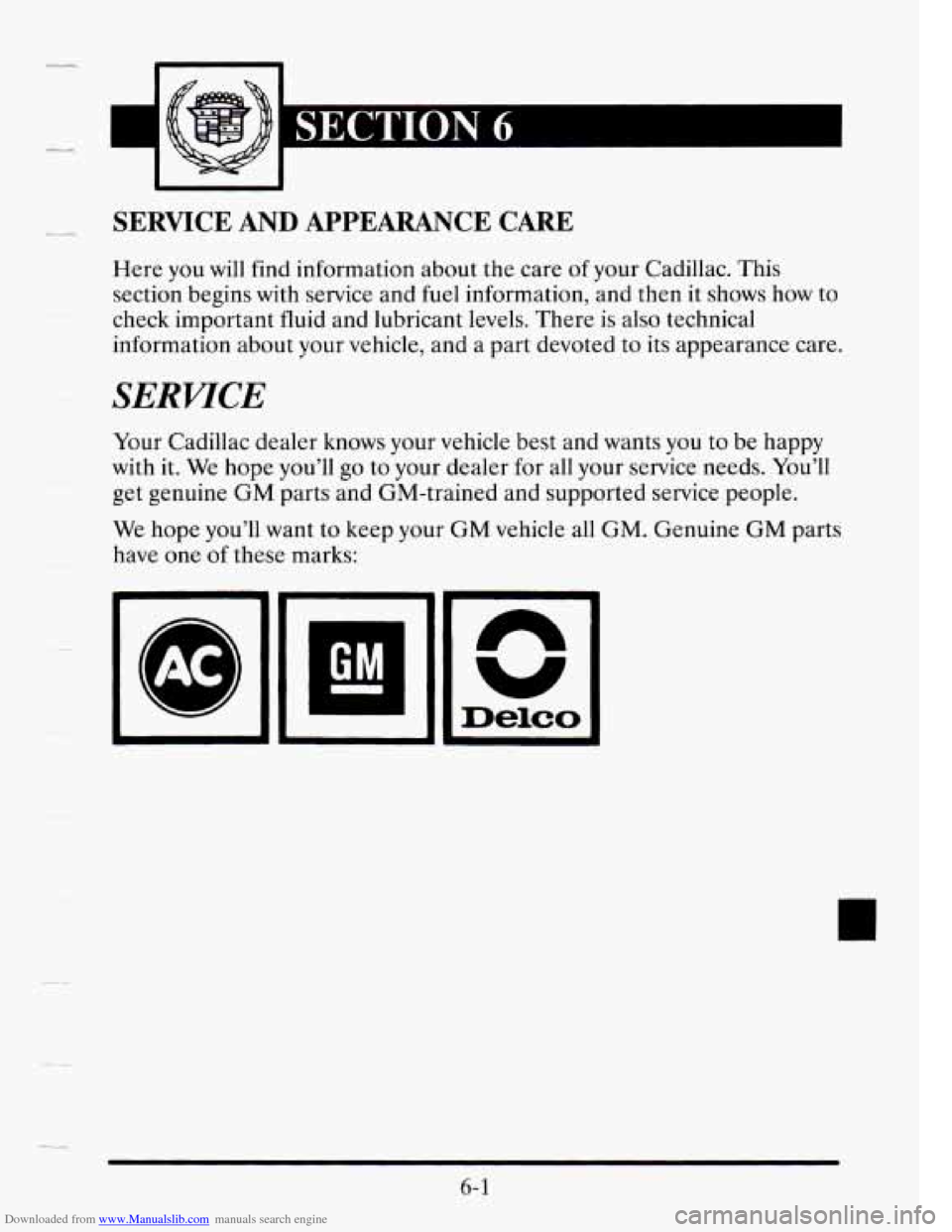
Downloaded from www.Manualslib.com manuals search engine Lu
SERVICE AND APPEARANCE CARE
Here you will find information about the care of your Cadillac. This
section begins
with service and fuel information, and then it shows how to
check important fluid and lubricant levels. There is also technical
information about your vehicle, and
a part devoted to its appearance care.
SERWCE
Your Cadillac dealer knows your vehicle best and wants you to be happy
with it. We hope you’ll go to your dealer for all your service needs. You’ll
get genuine GM parts and GM-trained and supported service people.
We hope you’ll want
to keep your GM vehicle all GM. Genuine GM parts
have one
of these marks:
Delco
6-1
Page 273 of 410
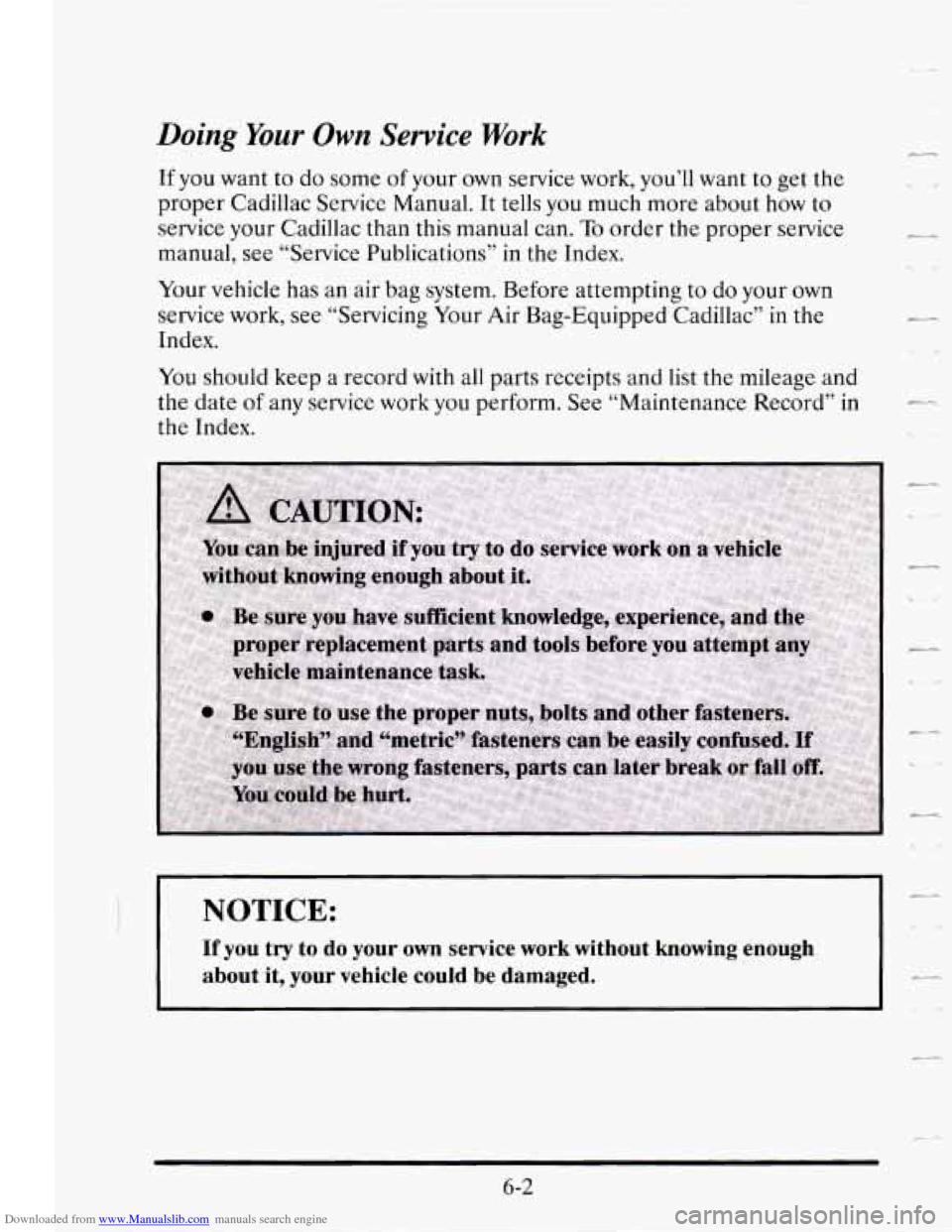
Downloaded from www.Manualslib.com manuals search engine Doing Your Own Service Work
If you want to do some of your own service work, you’ll want to get the
proper Cadillac Service Manual. It tells you much more about how to
service your Cadillac than this manual can.
To order the proper service
manual, see “Service Publications”
in the Index.
Your vehicle has an air bag system. Before attempting to do your
own
service work, see “Servicing Your Air Bag-Equipped Cadillac” in the
Index.
You should keep a record with all parts receipts and list the mileage and
the date of any service work you perform. See “Maintenance Record”
in
the Index.
NOTICE: I
If you try to do your own service work without knowing enough
about it, your vehicle could be damaged.
c-
6-2
Page 274 of 410
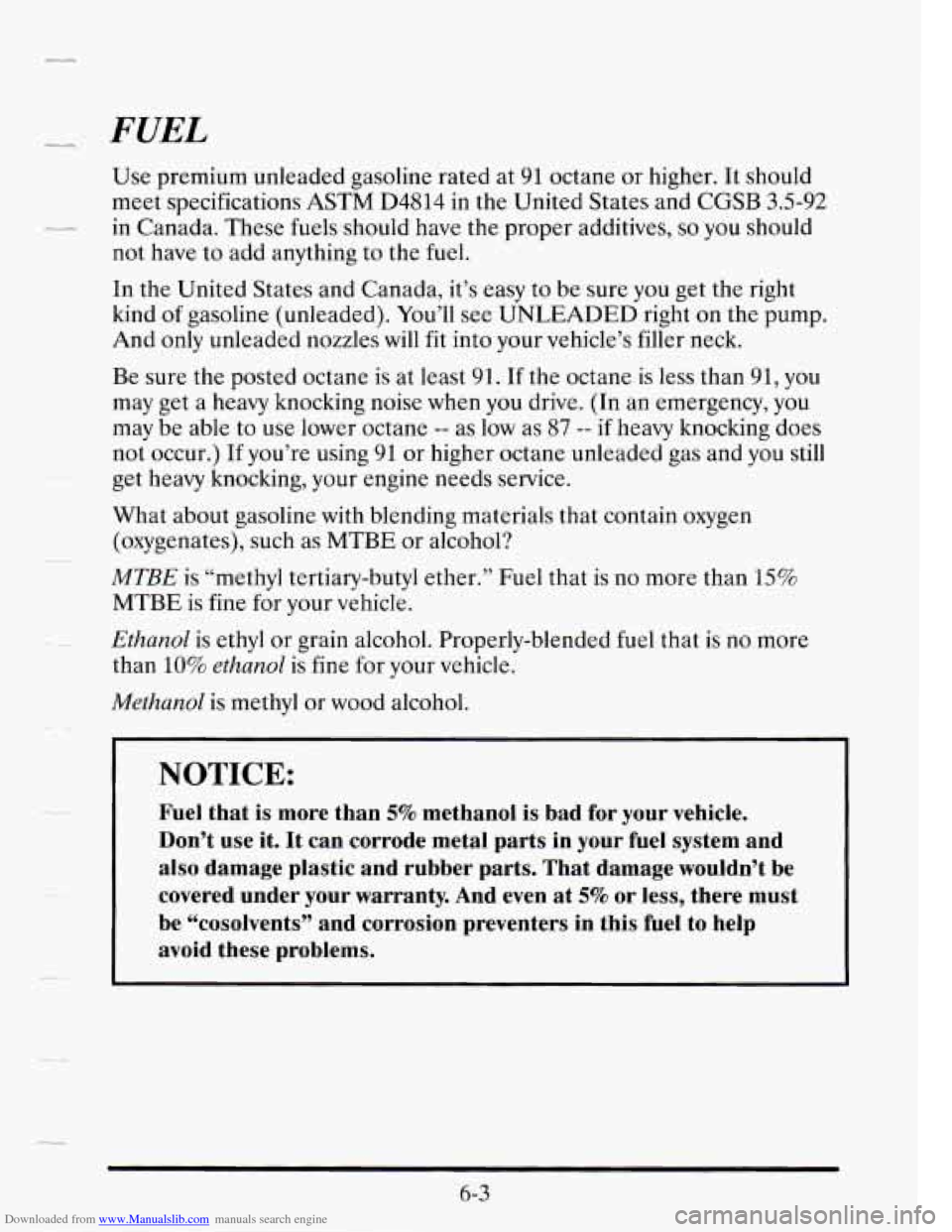
Downloaded from www.Manualslib.com manuals search engine -_ -
FUEL
Use premium unleaded gasoline rated at 91 octane or higher. It should
meet specifications
ASTM D4814 in the United States and CGSB 3.5-92
in Canada. These fuels should have the proper additives, so you should
not have to add anything to the fuel.
In the United States and Canada, it’s easy to be sure you get the right
kind
of gasoline (unleaded). You’ll see UNLEADED right on the pump.
And only unleaded nozzles will fit into your vehicle’s filler neck.
Be sure the posted octane
is at least 91. If the octane is less than 91, you
may get a heavy knocking noise when you drive. (In an emergency, you
may be able to use lower octane
-- as low as 87 -- if heavy knocking does
not occur.) If you’re using 91 or higher octane unleaded gas and you still
get heavy knocking, your engine needs service.
What about gasoline with blending materials that contain oxygen
(oxygenates), such as
MTBE or alcohol?
MTBE is “methyl tertiary-butyl ether.” Fuel that is no more than 15%
MTBE is fine for your vehicle.
Ethanol is ethyl or grain alcohol. Properly-blended fuel that is no more
than
10% ethanol is fine for your vehicle.
Methanol is methyl or wood alcohol.
I NOTICE:
Fuel that is more than 5% methanol is bad for your vehicle.
Don’t use it.
It can corrode metal parts in your fuel system and
also damage plastic and rubber parts. That damage wouldn’t be
covered under your warranty. And even at
5% or less, there must
be “cosolvents” and corrosion preventers in this fuel to help
avoid these problems.
6-3
Page 275 of 410
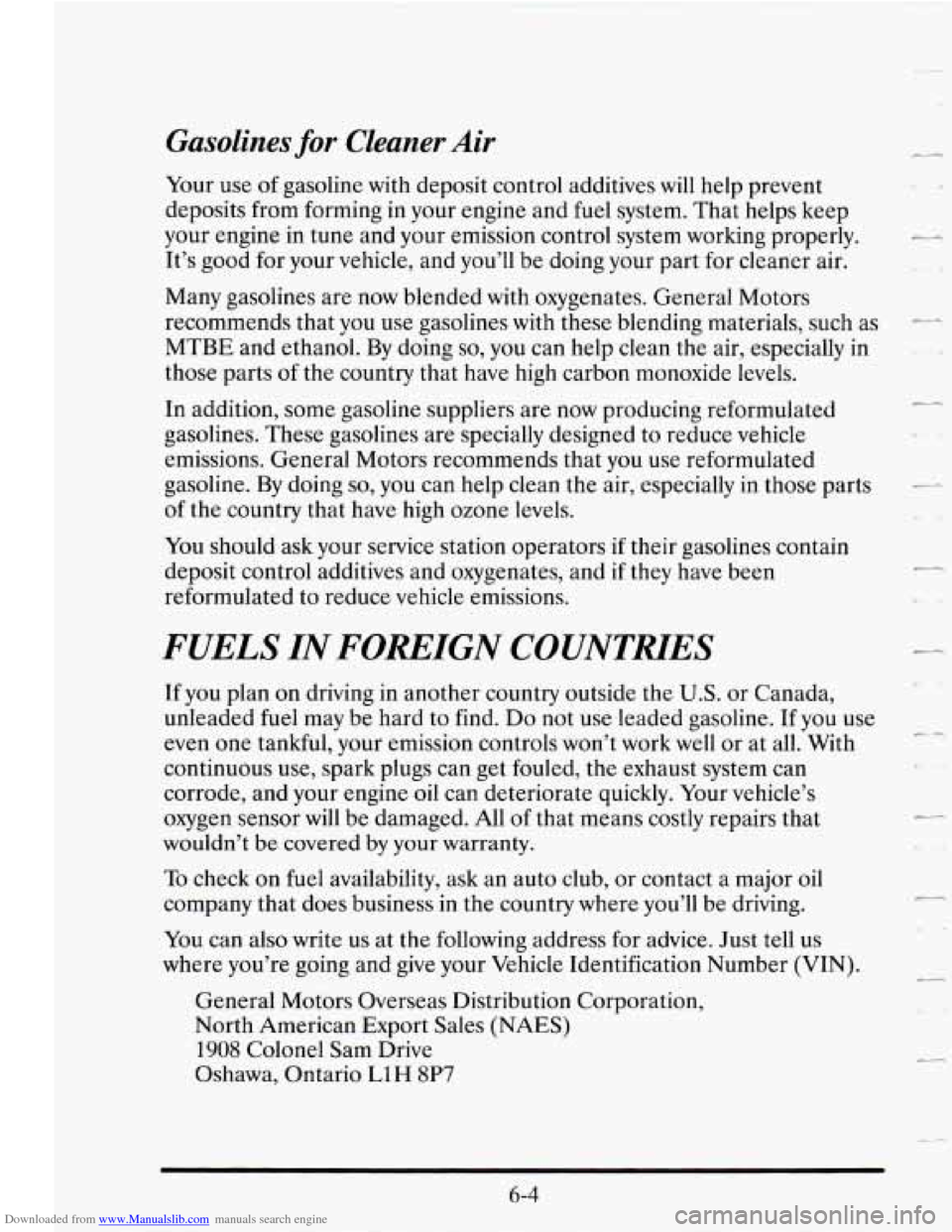
Downloaded from www.Manualslib.com manuals search engine Gasolines for Cleaner Air
Your use of gasoline with deposit control additives will help prevent
deposits from forming in your engine and
fuel system. That helps keep
your engine in tune and your emission control system working properly.
It’s good for your vehicle, and you’ll be doing your part for cleaner air.
Many gasolines are now blended with oxygenates. General Motors
recommends that you use gasolines with these blending materials, such as
MTBE and ethanol. By doing
so, you can help clean the air, especially in
those parts
of the country that have high carbon monoxide levels.
In addition, some gasoline suppliers are now producing reformulated
gasolines. These gasolines are specially designed to reduce vehicle
emissions. General Motors recommends that you use reformulated
gasoline.
By doing so, you can help clean the air, especially in those parts
of the country that have high ozone levels.
You should ask your service station operators if their gasolines contain
deposit control additives and oxygenates, and
if they have been
reformulated to reduce vehicle emissions.
FUELS IN FOREIGN COUNTMES
If you plan on driving in another country outside the U.S. or Canada,
unleaded fuel may be hard to find.
Do not use leaded gasoline. If you use
even one tankful, your emission controls won’t work well or at
all. With
continuous use, spark plugs can get fouled, the exhaust system can
corrode, and your engine
oil can deteriorate quickly. Your vehicle’s
oxygen sensor
will be damaged. All of that means costly repairs that
wouldn’t be covered by your warranty.
To check on fuel availability, ask an auto club, or contact a major oil
company that does business in the country where you’ll be driving.
You can also write us at the following address for advice. Just tell us
where you’re going and give your Vehicle Identification Number (VIN).
General Motors Overseas Distribution Corporation,
North American Export Sales
(NAES)
1908 Colonel Sam Drive
Oshawa, Ontario
L1H 8P7
6-4
Page 276 of 410
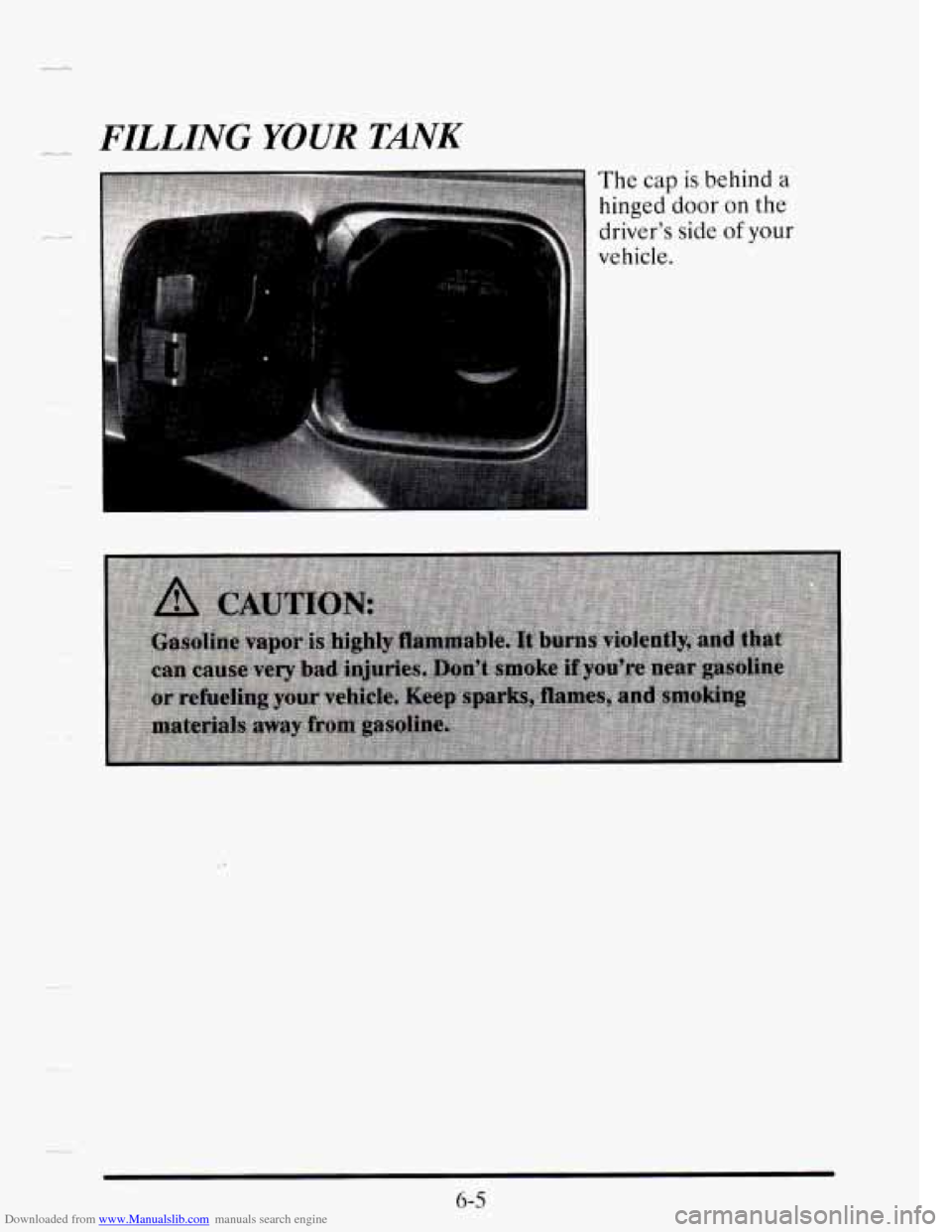
Downloaded from www.Manualslib.com manuals search engine c__ FILLING YOUR TANK
The cap is behind a
hinged door on the
driver’s side of your
vehicle.
6-5
Page 277 of 410
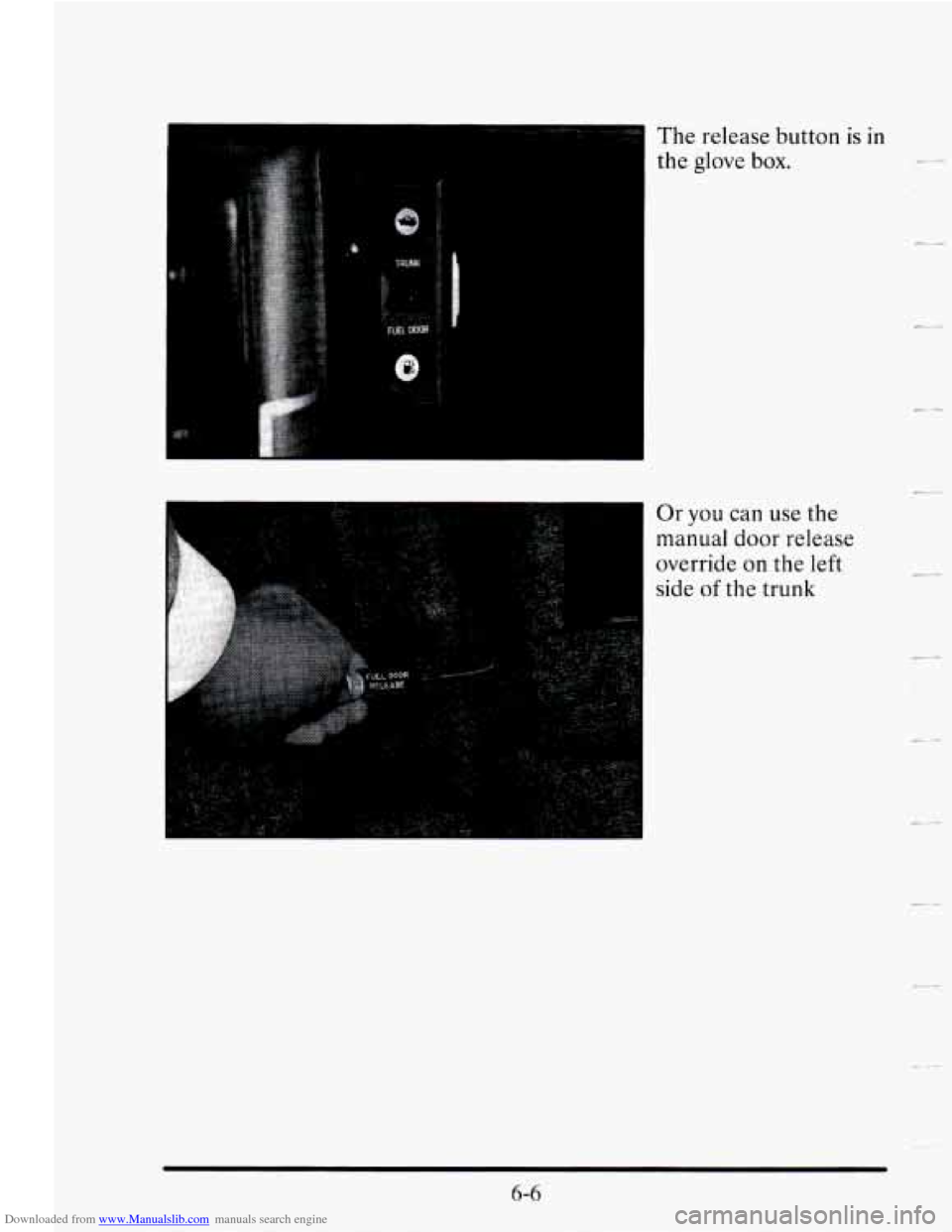
Downloaded from www.Manualslib.com manuals search engine The release button is in
the glove box.
Or you can use the
manual
door release
override on the
left
side of the trunk
6-6
L-
Page 278 of 410
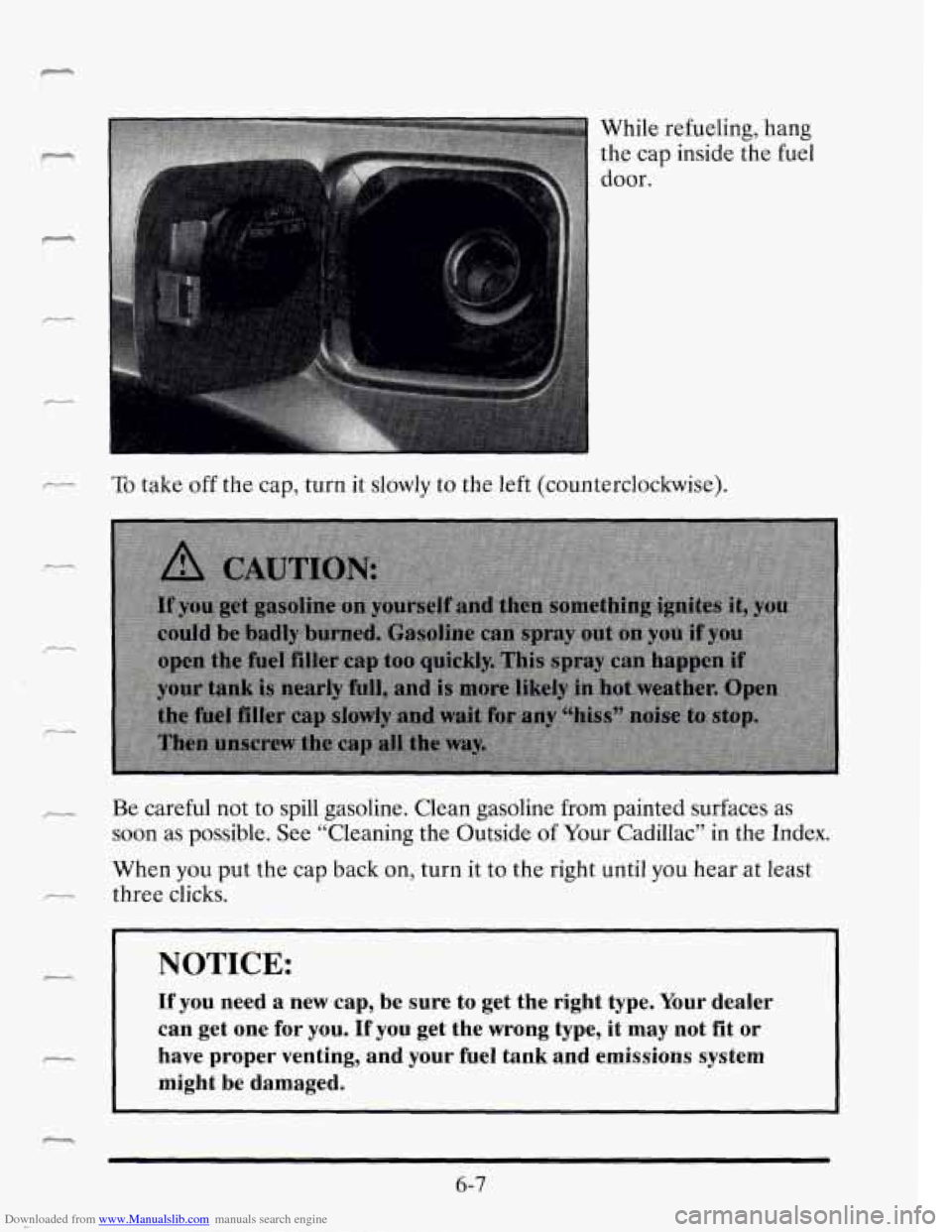
Downloaded from www.Manualslib.com manuals search engine P
r
While refueling, hang
the cap inside the fuel
door.
To take off the cap, turn it slowly to the left (counterclockwise).
Be careful not to spill gasoline. Clean gasoline from painted surfaces as
soon as possible. See “Cleaning the Outside
of Your Cadillac” in the Index.
When you put the cap back on, turn it to the right until you hear at least
three clicks.
NOTICE:
If you need a new cap, be sure to get the right type. Your dealer
can get one for you.
If you get the wrong type, it may not fit or
have proper venting, and your fuel tank and emissions system
might be damaged.
-,
6-7
Page 279 of 410
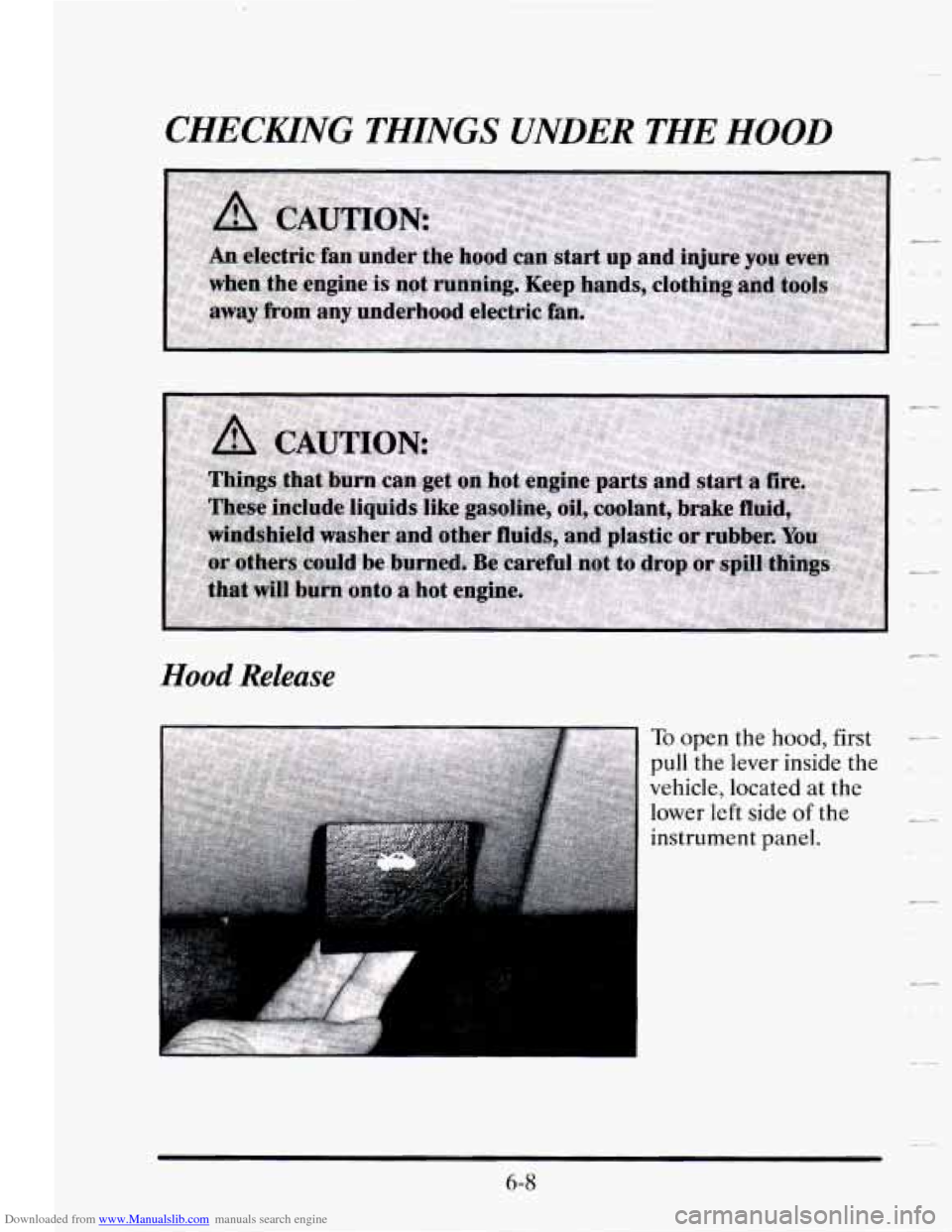
Downloaded from www.Manualslib.com manuals search engine CHECKING THINGS UNDER THE HOOD
,- -
Hood Release
6-8
Page 280 of 410
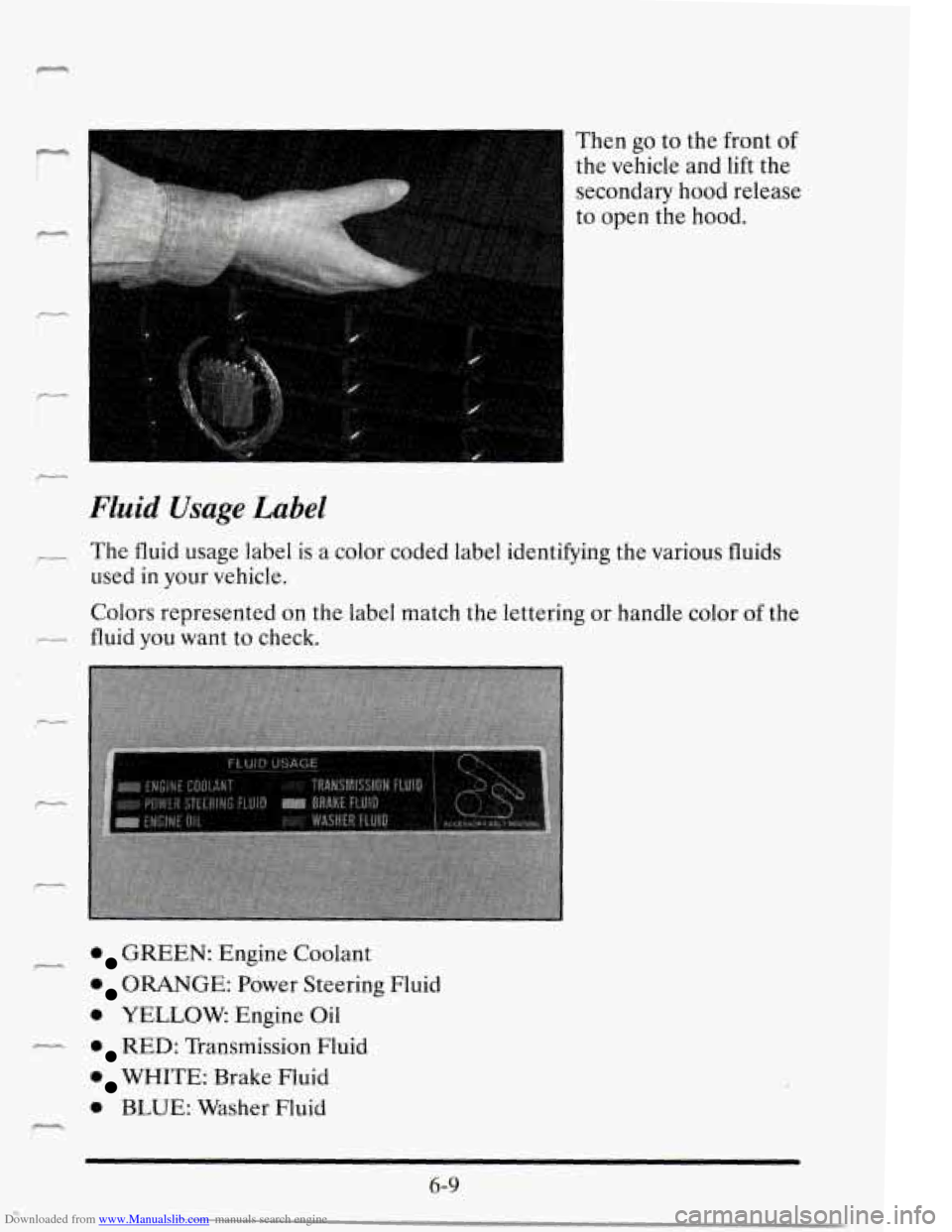
Downloaded from www.Manualslib.com manuals search engine c
Then go to the front of
the vehicle and lift the
secondary hood release
to open the hood.
Fluid Usage Label
The fluid usage label is a color coded label identifying the various fluids
used in your vehicle.
Colors represented on the label match the lettering or handle color of the
fluid you want to check.
GREEN: Engine Coolant
ORANGE: Power Steering Fluid
0 YELLOW. Engine Oil
RED: Transmission Fluid
WHITE: Brake Fluid
0 BLUE: Washer Fluid
P--+
6-9